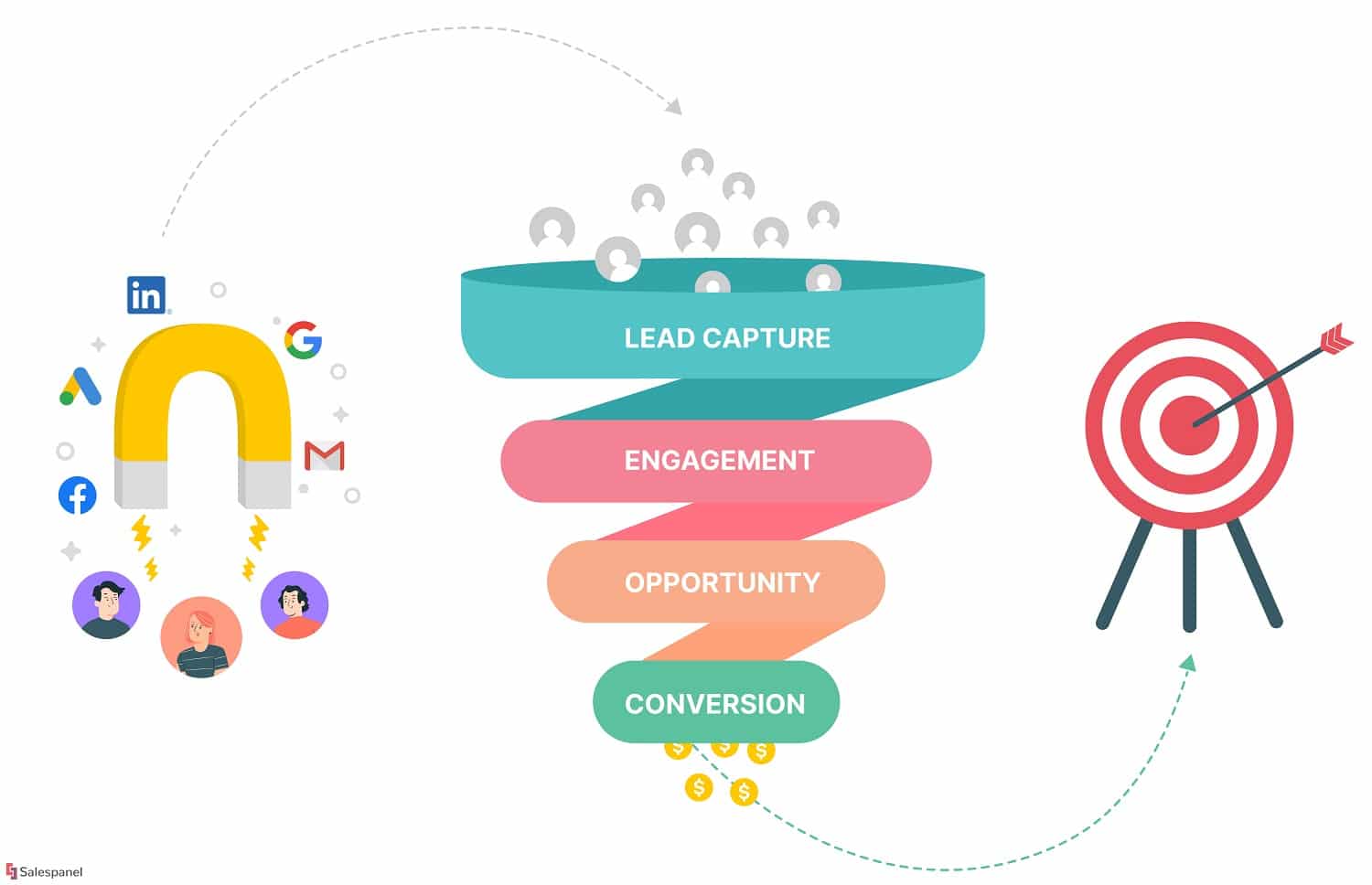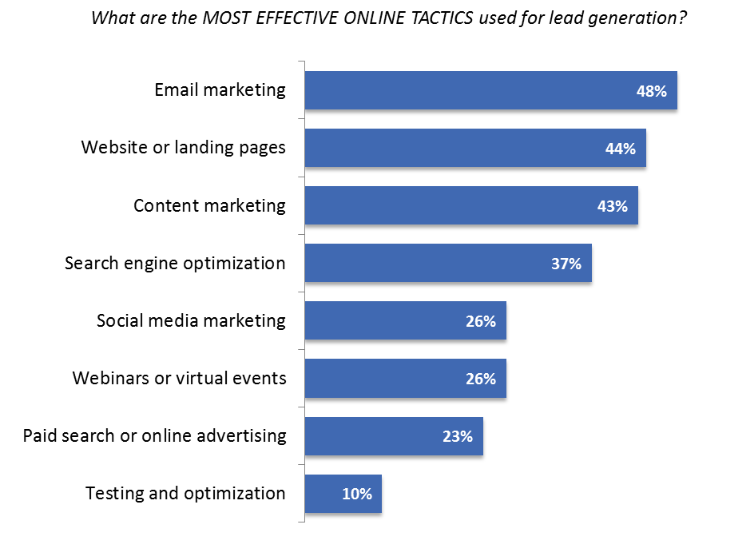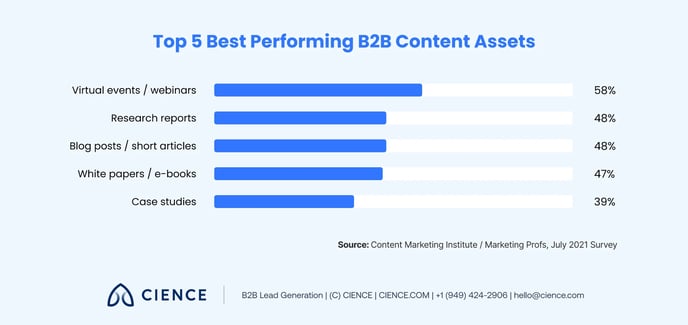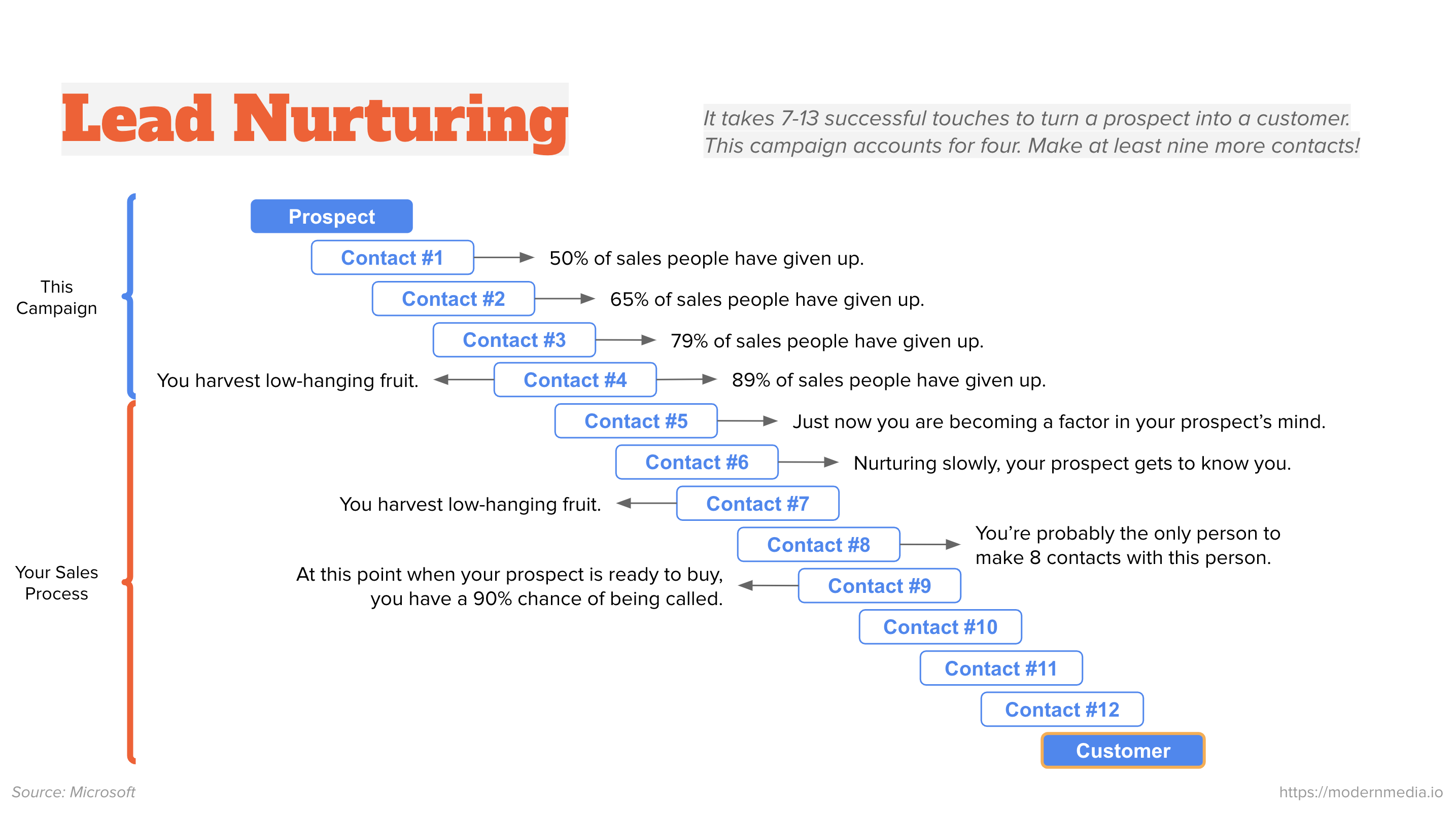Did you know that 68% of B2B companies struggle with lead generation, and only 13% of leads convert to opportunities? As a marketing or sales leader in a B2B industry, you're likely all too familiar with the unique challenges of fueling your sales pipeline with high-quality, ready-to-buy leads. But what if there was a proven playbook for success?
In this comprehensive guide, we'll walk you through the cutting-edge strategies and tactics that have helped our clients across industries like manufacturing, SaaS, and professional services achieve breakthrough results in their lead generation efforts. You'll get a step-by-step guide for maximizing your entire lead generation machine, from tapping into niche-specific platforms to crafting irresistible deals.

The State of B2B Lead Generation
Before diving into specific strategies, let's take a look at the current landscape of B2B lead generation:
- The average cost per lead has increased by 79% over the past decade
- Only 56% of B2B companies verify business leads before passing them to sales
- 80% of marketers report their lead generation efforts are only slightly or somewhat effective
Clearly, there's massive room for improvement. But where should you focus your efforts for maximum impact?
The Lead Gen Strategy Prioritization Framework

Not all lead gen strategies are created equal. To help our clients make smart decisions about where to invest, we've developed a proprietary framework for evaluating and prioritizing tactics based on three key factors:
Audience Fit
How well does this strategy align with the preferences and behaviors of your target buyers?
Competitive Differentiation
To what extent will this tactic help you stand out from the noise and capture attention?
Funnel Velocity
How quickly can you expect to see results, and how will this strategy impact your overall sales cycle?
By scoring each potential lead gen strategy against these criteria, you can build a tailored plan that maximizes your chances of success.
Case Study: Driving 300% ROI with Industry-Specific Webinars
One of our manufacturing clients was struggling to generate enough high-quality leads to keep their sales team busy. After conducting in-depth buyer persona research, we discovered that their target audience heavily relied on educational content to guide their purchase decisions.

Armed with this insight, we developed a series of industry-specific webinars featuring thought leaders and customer success stories. By promoting the webinars through targeted ads and organic social media, we were able to:
- Generate 500+ new leads per month
- Achieve a 25% conversion rate from registrant to attendee
- Drive a 300% return on investment within 6 months
The key to success was tailoring the content and promotion strategy to the unique needs and preferences of our client's buyer.
The Top B2B Lead Gen Channels and Tactics

So, what are the most effective ways to reach and convert B2B buyers? While the specific mix will vary by industry and target audience, here are some of the channels and tactics we see delivering the best results:
Trade Shows and Events
Despite the rise of digital channels, face-to-face interactions remain a powerful way to build relationships and generate leads. To maximize your trade show ROI:
- Invest in eye-catching booth design and collateral
- Staff your booth with knowledgeable, engaging reps
- Offer a compelling reason for attendees to share their contact info, like a high-value giveaway or exclusive content
- Follow up with leads within 24 hours to keep the momentum going
Thought Leadership Content
B2B buyers are hungry for insights that will help them solve their biggest challenges. By creating and promoting content that showcases your unique expertise, you can attract high-quality leads and position your brand as a trusted resource. Some formats to consider:
- Blog posts
- White papers
- Ebooks
- Infographics
- Webinars
- Podcasts
The key is to focus on topics that align with your target buyer's pain points and information needs at each stage of their journey.
Account-Based Marketing (ABM)
For companies with a more focused target market, ABM can be a highly effective way to generate leads from key accounts. The basic process:
- Identify and prioritize high-value accounts
- Develop personalized content and offers for each account
- Orchestrate multi-channel outreach (e.g. direct mail, email, ads)
- Measure and optimize based on engagement and conversion metrics
By treating each account as a market of one, you can create a highly relevant, irresistible experience that drives better lead gen results.
Using Data for Hyper-Targeted Lead Gen
Of course, none of these strategies will work if you're not reaching the right people with the right message at the right time. That's where data comes in.

By investing in tools like marketing automation, CRM, and lead enrichment platforms, you can gain a clearer picture of who your ideal buyers are, what they care about, and where they are in their journey. Armed with these insights, you can create hyper-targeted campaigns that speak directly to their needs and preferences.
Some specific ways to use data for better lead gen:
Segment your database by firmographic, behavioral, and intent data to create more relevant nurture streams
Score your leads based on fit and engagement to prioritize follow-up and allocate resources
Personalize your website and offers based on visitor demographics, behavior, and stage of the buyer's journey
Test and optimize your campaigns based on real-time performance data to continuously improve results
| Funnel Stage | Key Metrics | Optimization Tactics |
|---|---|---|
| Awareness | - Impressions - Website traffic - Social media engagement |
- Targeted advertising - SEO - Influencer partnerships |
| Consideration | - Lead capture rate - Content downloads - Webinar registrations |
- Compelling lead magnets - Landing page optimization - Lead capture forms |
| Decision | - MQL-to-SQL conversion rate - Sales accepted leads - Pipeline velocity |
- Lead scoring and grading - Sales enablement content - Lead recycling |

Optimizing Your Lead Gen Funnel
Generating initial interest is only half the battle. To turn those hand-raisers into qualified, sales-ready leads, you need a well-oiled lead gen funnel. Here's a step-by-step guide:
1. Define Your Lead Qualification Criteria
Work with sales to clearly define what constitutes a marketing qualified lead (MQL) and sales qualified lead (SQL) based on factors like:
- Budget
- Authority
- Need
- Timeline
- Fit
Document these criteria in a service-level agreement (SLA) to ensure marketing and sales alignment.
2. Create Compelling Lead Magnets
To persuade buyers to share their contact info, you need to offer something of value in return. Some high-converting lead magnet ideas:
- Ebooks
- White papers
- Case studies
- Assessments
- Free trials
- Demos
Make sure your lead magnets are closely tied to your product or service and provide immediate, tangible value.
3. Build High-Converting Landing Pages
Your landing pages should be laser-focused on a single offer and call-to-action. Key elements to include:
- A clear, benefit-focused headline
- Concise, scannable copy that highlights key value props
- Eye-catching visuals like images, videos, or infographics
- A short, easy-to-complete form (only ask for the info you really need)
- Trust-building elements like customer logos, testimonials, or security badges
Test different versions of your landing pages to continually improve conversion rates.
4. Develop Lead Nurturing Sequences
Once a lead converts, it's important to keep the conversation going until they're ready to buy. A well-crafted lead nurturing sequence can help you:
- Educate prospects on their key challenges and your solution
- Build trust and credibility through consistent, valuable communication
- Accelerate the buyer's journey by addressing common questions and objections
- Identify sales-ready leads based on engagement and behavioral cues
Map out your nurture sequences based on your buyer's journey and the typical length of your sales cycle. Use a mix of content formats (e.g. email, retargeting ads, direct mail) to keep things interesting.
5. Enable Seamless Sales Handoffs
When a lead meets your agreed-upon SQL criteria, it's time to get them in front of a salesperson. To ensure a smooth handoff:
- Notify sales reps immediately when a lead becomes an SQL
- Provide full context on the lead's engagement history and key interests
- Use lead routing rules to assign leads to the right rep based on territory, industry, or other criteria
- Set up a closed-loop reporting process to track lead outcomes and gather feedback from sales
By optimizing each stage of your lead gen funnel, you can maximize conversions and keep your pipeline full of high-quality, ready-to-buy leads.

Avoiding Common Lead Gen Pitfalls
Of course, even the best-laid plans can go awry. Here are some common mistakes to avoid in your B2B lead gen efforts:
Failing to align with sales: Make sure marketing and sales are working towards the same goals and have a shared understanding of what constitutes a qualified lead.
Focusing on quantity over quality: It's better to have a smaller number of high-fit, engaged leads than a large database of unqualified contacts.
Neglecting lead nurturing: Don't assume that a single touchpoint will be enough to convert a lead. Invest in ongoing nurture campaigns to build relationships over time.
Ignoring data hygiene: Regularly clean and update your database to avoid wasting time and resources on invalid or outdated contacts.
Overlooking the post-sale experience: The buyer's journey doesn't end at the sale. Continue engaging customers with valuable content and offers to drive retention and advocacy.
By staying alert to these common pitfalls, you can keep your lead gen engine running smoothly and efficiently.
The Future of B2B Lead Generation

As buyer behaviors and technologies continue to evolve, so too must your approach to lead generation. Here are some trends and emerging tactics to keep on your radar:
Conversational marketing: Using chatbots and live chat to engage visitors in real-time and guide them through the buyer's journey.
Personalized video: Using customer data to create highly relevant, one-to-one video content that drives engagement and conversions.
AI-powered lead scoring: Using machine learning algorithms to analyze large datasets and predict which leads are most likely to convert.
Voice search optimization: Optimizing your content and website for voice-based searches to capture leads via smart speakers and digital assistants.
Influencer partnerships: Partnering with industry thought leaders and influencers to expand your reach and build trust with your target audience.
| Trend | Adoption Rate | Potential Impact |
|---|---|---|
| Conversational Marketing | 35% | - Improved lead quality - Higher conversion rates - Better customer experience |
| AI-Powered Lead Scoring | 25% | - More accurate lead prioritization - Increased sales efficiency - Reduced customer acquisition cost |
| Personalized Video | 15% | - Increased email open and click-through rates - Higher engagement and conversion rates - Stronger brand affinity and recall |
By staying ahead of the curve and continually experimenting with new tactics, you can gain a competitive edge and drive sustainable growth for your business.
Your Lead Gen Success Roadmap
Generating a consistent stream of high-quality leads is no easy feat, but with the right strategies and tactics in place, it's entirely achievable. By applying the insights and best practices outlined in this guide, you can build a lead gen engine that:
- Aligns with your target buyer's unique needs and preferences
- Harnesses the power of data for hyper-targeted, personalized outreach
- Optimizes each stage of the funnel for maximum conversions
- Enables seamless collaboration between marketing and sales
- Drives predictable, scalable revenue growth
| Timeline | Key Milestones |
|---|---|
| Month 1 | - Conduct lead gen audit - Set SMART goals - Develop lead gen strategy |
| Month 2 | - Implement high-priority tactics - Launch lead nurturing campaigns - Establish marketing-sales SLA |
| Month 3 | - Optimize landing pages and lead magnets - Test new channels and tactics - Review and refine lead scoring model |
| Month 4+ | - Scale successful tactics - Continuously monitor and optimize performance - Explore emerging trends and technologies |
So what are you waiting for? It's time to put this playbook into action and start fueling your sales pipeline like never before. If you need help along the way, our team of B2B lead gen experts is here to guide you every step of the way. Contact us today to learn more about how we can help you achieve your growth goals.
FAQ
- Q: What's the difference between a lead and a prospect?
A: A lead is an individual or organization that has shown interest in your product or service, typically by providing their contact information. A prospect, on the other hand, is a lead that has been qualified based on certain criteria and is deemed more likely to make a purchase. - Q: How can I improve the quality of my B2B leads?
A: To improve lead quality, focus on targeting the right audience, creating compelling offers, and using lead scoring and grading to prioritize the most promising leads. Regularly review and refine your lead qualification criteria in collaboration with your sales team. - Q: What's the best way to measure the success of my lead generation efforts?
A: Key metrics to track include cost per lead (CPL), marketing qualified lead (MQL) rate, sales qualified lead (SQL) rate, and lead-to-customer conversion rate. Set benchmarks based on industry standards and your own historical performance, and regularly review your progress. - Q: How often should I update my lead generation strategy?
A: Your lead generation strategy should be a living document that you revisit and refine regularly based on performance data, market trends, and feedback from your sales team. Aim to conduct a comprehensive review at least once per quarter, with more frequent check-ins as needed. - Q: What's the most effective lead generation channel for B2B companies?
A: The most effective lead generation channel will vary depending on your industry, target audience, and unique value proposition. That said, tactics like content marketing, search engine optimization (SEO), email marketing, and events tend to be consistently effective for B2B companies. - Q: How can I use data to improve my lead generation targeting?
A: Use demographic, firmographic, and behavioral data to create targeted segments and personalize your outreach. Use intent data to identify leads that are actively researching your solution, and prioritize them for sales outreach. - Q: What's the ideal length for a B2B lead generation form?
A: In general, shorter forms tend to have higher conversion rates, while longer forms can help qualify leads more effectively. Aim to strike a balance by asking for the minimum amount of information needed to determine fit and follow up effectively, typically around 3-5 fields. - Q: How can I get more leads from my website?
A: Optimize your website for lead generation by creating compelling content offers, using clear calls-to-action (CTAs), and designing landing pages that drive conversions. Use A/B testing to continually refine your approach and improve performance over time. - Q: What's the best way to follow up with leads?
A: The best follow-up approach will depend on your specific audience and offering, but in general, aim to respond quickly, personalize your outreach, and provide value at every touchpoint. Use a mix of channels (e.g., email, phone, social media) and experiment to see what works best. - Q: How can I align my marketing and sales teams for better lead generation?
A: Foster alignment by establishing clear definitions of MQLs and SQLs, setting shared goals and metrics, and maintaining open lines of communication. Consider implementing a service-level agreement (SLA) that outlines each team's responsibilities and commitments.




